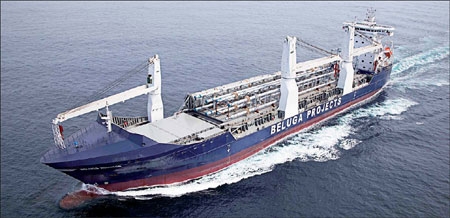Movers & shippers

|

Heavy lift ship [Provided to China Daily] |
As Chinese shipyards become less dependent on the European market, there have been more deals with the US, Canada and the nations of Scandinavia, where there is a growing demand for Chinese ships.
Yangzijiang Shipbuilding Holdings Ltd, based in Jiangsu province, obtained the biggest order in its company history in signing a $2.5 billion contract with Canadian shipping giant Seaspan Marine Corp last year for 25 10,000-TEU container vessels, the biggest container vessel contract in China. These vessels will be delivered in 2014 and 2015.
"Having these big contracts in place shows that large Chinese shipbuilders are fully capable of producing high-value-added ships to compete with South Korean rivals and shake their monopolistic position in the global market for mega-containers," says Yangzijiang Shipbuilding spokesperson Zhang Yao.
Zhang says the Chinese shipping industry is facing increasing challenges from buyers to reduce the operating costs for ships and improve energy efficiency.
"We have all seen the dramatic transformation caused by the global economic crisis, which has created a buyer's market," Zhang says.
Yangzijiang Shipbuilding signed a preliminary agreement with China Development Bank and Germany's Peter Dohle Schiffahrts-KG to build eight 10,000-TEU container vessels last year. China Development Bank will provide $1 billion in financing over the next five years to enable the German company to purchase ships from Yangzijiang Shipbuilding.
But there are major problems for the shipbuilding industry in China, which saw total revenue of $95.3 billion in 2010 and revenue in exports of $40 billion. Under the current global economic climate, a number of shipowners from Europe do not have sufficient funds to support long-term shipbuilding projects that generally take one to two years to complete. Many Chinese shipbuilders, as a result, are struggling to complete their orders quickly and cheaply.
Officials at Nantong Mingde Group, a private-owned shipyard also based in Jiangsu province, said the company is more inclined to increase business activities with foreign buyers that didn't suffer as greatly in the recession or have at least recovered quickly from the recession.
Mingde stopped its business partnership with southern European nations, especially with Greece, four years ago. The company has been betting on the rising demand of chemical tanker ships and vehicle carriers.
"I would rather make deals with giants from North Europe, US and Canada, who are capable of making payments and don't have credit problems in their countries," says Ji Fenghua, board chairman of Mingde.
Countries such as Norway, Denmark and Germany, major manufacturers of chemical products, reportedly have a rising demand for chemical tankers to transport high-contamination liquids or materials.
In 2011, Mingde delivered 12 ships to buyers from Norway, Denmark, Germany and Singapore, including four chemical tanker carriers and two vehicle carriers. Sales reached $410 million last year, with a profit of $20 million.
Ji says one reason for Mingde's success is that it has adopted new designs for ship buyers. Japanese and South Korean shipbuilders, he says, insist on using their own design to build ships to avoid financial risks.
"(Adopting new designs), even though it is quite costly, has played an important role in gaining a favorable impression from (buyers)," he says.
Torbjorn Sjoblom, a Swedish site team manager who works for Norway's Jo Tankers, one of the world's main providers of deep-sea transportation services for chemicals, says China's ability to "offer high-quality design and after-sales services significantly improves the marketing credibility of Chinese shipyards on the international stage".
Today's Top News
- Xi calls for promoting volunteer spirit to serve national rejuvenation
- Xi chairs CPC meeting to review report on central discipline inspection
- Reunification will only make Taiwan better
- Outline of Xi's thought on strengthening military published
- Targeted action plan to unleash consumption momentum
- Separatist plans of Lai slammed






























